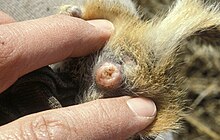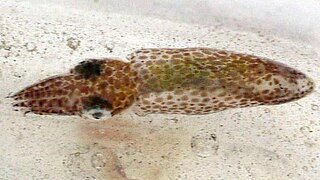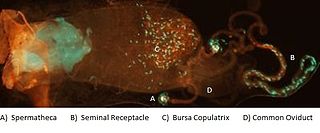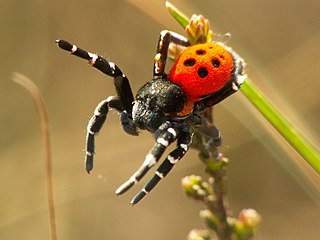Mechanisms of cryptic female choice
Many mechanisms exist in the animal world that allow females to practice cryptic female choice by manipulating which reproductive events are successful or not. These choices can occur at varying stages of the reproductive process.
Pre-copulation
Pre-Copulation – female cryptic choice can include physical, anatomical, and chemical barriers that can promote or hinder a male's success in the mating process. [1] : 45
Morphology
(Physical/Anatomical): At the pre-copulatory level female cryptic choice consists of the physical and anatomical barriers that females use to decide whether a male is successful or not. This can fall under two subcategories as a result of mating strategies:
- Antagonistic coevolution: Among species that mate multiple times, studies have shown much greater divergence in genital morphology than in species who mate singly. The rapid evolution of internal female and male reproductive morphology is due to the high sexual selection pressures characteristic of polygamous populations. In such cases, females can use cryptic female choice in choosing for or resisting males with specific physical or anatomical traits. [1] : 22 Duck genitalia and anatomical evolution is a prime example of this male-female conflict through evolution of internal anatomical barriers. [3]
- Coevolution: Female cryptic choice may also act indirectly by choosing for males with subtle secondary sexual traits that may cater to easier insemination and mating. In these instances female cooperation during the mating process is crucial for male success. For example, in the yellow fever mosquito, successful copulation requires a multistep process with a cooperative and receptive female. [1] : 97 In the Caribbean fruit fly, males must display a specific calling song to induce female cooperation which allows the male to penetrate the female deeply, increasing his chances of success. [1] : 101
In both cases, without the compliance of the female, the male will be unsuccessful in his mating attempt. As such, females can choose for specific male traits by hindering complete intromission or ejaculation during mating.
Chemical
At the pre-copulatory level female cryptic choice can also be employed through chemical means to allow for mating with some males while deceiving other males.
- Masking estrus cycle : Female cryptic choice can also occur when females mask their estrus cycle. Specifically in mammals, by hiding the timing of their estrus cycle, females can avoid male control and pursue their own reproductive strategies. This way a female in estrus can sometimes avoid being swamped by competing males or she can prevent male harassment, coercion, or forced mating. [4]
Insemination
Female cryptic choice can also occur after the male has mated and released his sperm.
- Copulation times: A longer copulation time generally means increased mating success for a male. A female may exercise cryptic female choice by determining whether a male can mate for longer or for shorter periods of time, thus increasing or decreasing male insemination success. In hanging flies, females allows males that provide larger nuptial gifts to copulate longer, which increases male fitness. [1] : 69 In the tiger beetle, females sometimes forcefully terminate a copulation to deny male insemination. [1] : 127
- Discard current sperm: During most copulatory events, only a fraction of a male's sperm is usually taken up and stored by the female. In some species, females can sometimes discard sperm by sperm ejection, releasing sperm after mating so that they are free to mate again if another, more preferred male comes along. Females can also sometimes exercise cryptic female choice by mating several times and selectively discarding sperm from certain males while retaining those from preferred males. In Drosophila flies and in field crickets, females mate multiply and select for sperm or spermatophores of certain males. [1] : 17, 88
- Destroy current sperm: Females can also exercise cryptic female choice by committing spermatocide. They can sometimes destroy stored male sperm through various means, usually chemically (raising pH, hormones, bodily chemical fluids, etc.) after a mating to allow for a second male to successfully inseminate her.

Copulatory plug - Copulatory plug: After inseminating a female, certain species of males will then insert a copulatory plug to prevent females from mating again, or to discourage or prevent other males from displacing their sperm. Some females have the ability to either keep or remove the plug and thus choose which sperm they select to keep. Females can remove this plug so they may successfully re-mate again if a better prospect comes along. [1] : 146
- Sperm-transplant: Females can also exercise cryptic female choice by preventing the transfer of sperm to a storage organ or fertilization sites. This can occur through various means such as muscular contractions, hormones, nervous control, or bodily fluids or chemicals, etc. In some lab rats females demonstrated their ability to halt sperm transport by re-mating more quickly after certain mating events. [1] : 106
- Make subsequent sperm transfer more difficult morphologically: Females can sometimes influence ease of sperm transfer during mating. In certain species of arthropods, such as the golden silk spider, some females can change the rate at which the cuticle of their genitalia hardens to manipulate ease of sperm transfer. [1] : 179
Fertilization
Females can also exercise cryptic female choice during the fertilization processes.
Sperm bias in storage or transportation
By utilizing sperm storage and transplant, females can exercise cryptic female choice by storing or transplanting sperm to bias sperm success rates towards certain males. [1] : 166
- Adjacent sperm storage organs: Females can sometimes store sperm in adjacent organs, especially when they mate multiply and thus give unequal preference to certain males. In many polygamous species, males often have the ability to displace a previous male's sperm. In response to this, females retain control of sperm choice by using multiple sperm storage sites to exercise cryptic female choice. By moving sperm to adjacent organs females can prevent particular sperm from being displaced and save the displaced sperm for fertilization. Moving the sperm can also prevent it from continuing on in the fertilization process. In the Dryomiza anilis fly and in the flour beetle, females choose sperm from a number of different storage locations. [1] : 169 In the red flour beetle, females often possess several storage receptacles for sperm from different males, and can choose which sperm to utilize for fertilization. [5]
- Sperm transplant: Similar to sperm storage mechanisms of cryptic female choice, females can exercise cryptic female choice by promoting or hindering sperm movement in and out of the reproductive tract into storage structures through muscular contractions.
Failing to prepare uterus for embryo implantation
Females can control hormonal signals that halt embryo preparation to keep sperm from successfully fertilizing the embryo. They can also promote or hinder ovulation as a means of exercising cryptic female choice. By hindering ovulation, a copulatory interaction may be deemed unsuccessful. In rats and golden hamsters, females denied a male's success by failing to prepare their uterus based on male stimulation. [1] : 143
Select for or against sperm during hyperactivation
After insemination, male sperm are relatively slow and inert in the reproductive tracts or storage areas of the female and are only activated by calcium ionophores in vitro. Thus by releasing or withholding the necessary ions to activate the sperm, females can promote faster motility of sperm towards the egg for fertilization or hinder it by slowing their motility and allowing them to die before they reach the egg respectively. [6]
Choosing from among sperm to reach the egg
Female ovarian fluids can promote or hinder sperm especially if they have complementary or uncomplimentary chemical signals. Some females may also physically choose from among spermatophores taken from multiple matings.
Failure to ovulate
Females can sometimes change their differential ovulation responses based on male stimuli to affect male reproductive success. In lions some females will reduce fertility after the male commits infanticide, resulting in low offspring counts after a new male takes over a pride. [1] : 135
Gestation
Even after fertilization has occurred, females can exercise cryptic female choice.
- Abortion: By aborting the zygote or the fetus through female resistance or acceptance of male induced abortion signals, a female can exercise cryptic female choice. [1] : 162
- Reduce rate of offspring produced: Females can sometimes adjust rates of oviposition to determine the number of successful offspring a male's sperm will produce after a mating event. In the leaf-rolling frog, females can delay spawn times which determines the number of final offspring produced from a mating event. [1] : 124
- Fail to mature eggs: Some females can deny male reproductive success by controlling the development and maturation of eggs in her ovary. In the red garter snake, some females failed to produce eggs after a mating event. [1] : 140
Post-birth
Even after birth has occurred, females can manipulate male offspring success.
- Invest less in each offspring: by altering rates of investment in an offspring, a female can sometimes exercise cryptic female choice. [1] : 184

















